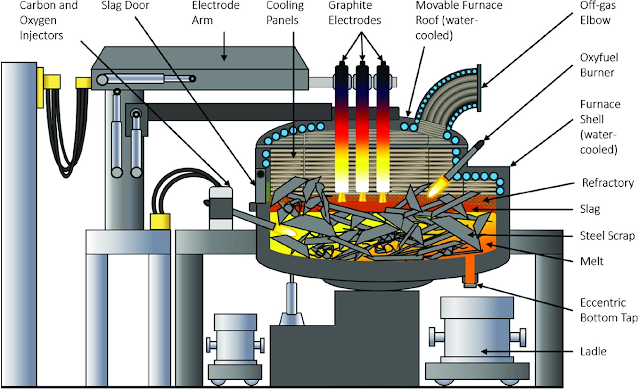What is Electric Arc furnace?
An electric arc furnace is an electric furnace that melts metals and ores at high temperatures produced by electrode arcs. When gas discharge forms an arc, the energy is very concentrated and the temperature in the arc zone is above 3000 C. For smelting metal, the electric arc furnace is more flexible than other steelmaking furnaces and can effectively remove impurities such as sulfur and phosphorus. The furnace temperature is easy to control and the equipment covers a small area. It is suitable for smelting high-quality alloy steel.
Classification
Arc furnaces can be divided into indirect heating, direct heating, and submerged arc according to the heating mode.
1. The indirect heating electric arc furnace is that the electric arc is produced between the two electrodes, which does not touch the material and heats the material by heat radiation. This furnace is noisy, inefficient, and gradually eliminated.
2. The direct heating electric arc furnace is the electric arc generated between the electrode and the material, which directly heats the material. Three-phase electric arc furnaces for steelmaking are the most commonly used direct heating electric arc furnaces.
2. Submerged arc circuit is also called a reduction electric furnace or mineral heat furnace. One end of the electrode is embedded in the material layer, which forms an arc and heats the material by using the resistance of the material layer itself. It is commonly used for smelting ferroalloys, nickel matte, copper matte, and carbide production.
Composition
1. Power supply: electric furnace transformer (rectifier), high-voltage power supply, low-voltage electrical control cabinet, etc.
2. Electrode parts: electrode lifting device, conductive cross arm, electrodes, etc.
3. Furnace body parts: shell, cover, tilting mechanism, etc.
4. Short mesh parts: conductive copper bars, water-cooled cables, etc.
5. Cooling water system.
Working Principle
Electric arc furnace smelting uses the heat generated by the arc between the graphite electrode and the iron (liquid iron) to melt the iron and overheat the liquid iron. During the process of electric arc furnace smelting, the smelting operation to further increase the temperature and adjust the chemical composition after the iron is melted is carried out under the condition that the slag covers the molten iron. The electric arc furnace is divided into acidic and alkaline according to the properties of slag and lining refractories. Alkaline electric arc furnaces are capable of desulfurizing and dephosphorizing.
Advantages and Disadvantages
The advantage of electric arc furnace smelting is its strong ability to melt solid charge, the molten iron is superheated and the chemical composition is adjusted under the condition of slag covering, so it can avoid the aspiration of molten iron and the oxidation of elements to a certain extent. This creates good conditions for smelting low carbon and alloy cast iron.
The disadvantage of electric arc furnace is that it consumes much electric energy and is not as economical as the cupola from the point of view of melting. Therefore, the cupola-electric arc furnace duplex melting method is often used in the production of cast iron. Because the lining of alkaline electric arc furnace has poor resistance to rapid cooling and heat, and its service life is short under the condition of intermittent smelting, the smelting cost is high. Therefore, acid electric arc furnace is mostly used in combination with cupola furnace.
Application
1. Steel smelting and ferroalloy refining;
2. Melting of high titanium slag and welding slag flux;
3. Melting of high-temperature refractories such as alumina, magnesium oxide, and aluminum-calcium cement;
4. Melting of stainless steel grinding wheel ash and oxide scale.
Free send inquiry to stella@hanrm.com if any needs.
Whatsapp/Wechat:+8615877652925
Website: https://www.hanrm.com




.jpg)








没有评论:
发表评论